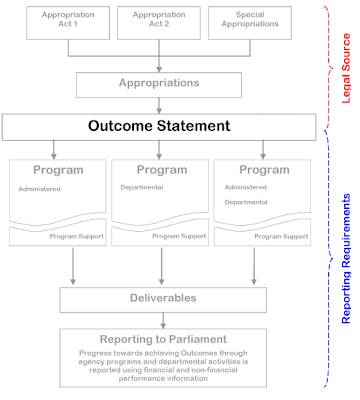Australia
The Australian government introduced an
Outcomes and Outputs Framework as the basis for budgeting and reporting for public sector agencies in 1999–2000. Among the main elements of the framework are:
• Specification of what the government is trying to achieve (outcomes);
• Specification of how actual deliverables will assist in achieving the outcomes (outputs); and
• Annual performance reporting of agencies’ contribution to the achievement of outcomes and the delivery of outputs (
Australian National Audit Office, 2007, p. 15). Annual reports to Parliament detail the degree to which plans for the coming budget year are realized and targeted performance is achieved.
CanadaCanada has had an Improved Reporting to Parliament project running since the 1990s. Thirteen broad Government of Canada outcomes are specified, and agencies must develop clearly defined and measurable strategic outcomes that link in to these over-arching outcomes. Departmental performance reports are intended to provide a comprehensive but succinct picture of departmental performance, as it compares against the strategic outcomes, through the reporting of program activities linked to the strategic outcomes (Treasury Board of Canada, 2007). An effort is being made to refocus reporting away from governmental out¬puts to higher-level outcomes that show how agencies make a difference to citizens.
IrelandIn Budget 2006, the Minister for Finance indicated that the government had decided that, starting in 2007, individual departments would publish an annual state¬ment on the outputs and objectives of their depart-ments, and from 2008, the actual out-turns. These statements (named output statements) are presented to the relevant parliamentary committee along with the department’s annual estimates. Guidance from the Department of Finance suggests that, with regard to reporting on performance, a small number of high-level goals per department—each with a macro level outcome indicator—should be complemented by a small number of more detailed output indica¬tors which should, where possible, be quantitative in nature; otherwise, qualitative.
United StatesThe
Government Performance and Results Act of 1993 requires federal agencies to produce strategic plans, annual performance plans, and annual performance and accountability reports (PARs). These are aimed at establishing a system of accountability whereby agencies articulate what they are trying to achieve, how they will accomplish it, and how Congress and the public will know if they are succeeding (Breul, 2007, p. 313). Goals and objectives need to be stated as outcomes, and performance indicators must be valid indicators of the impact on outcome goals (
Department of Energy, 2006).
For more read, a report by Richard Boyle, Head of Research for the
Institute of Public Administration in Dublin, '
Performance Reporting: Insights from International Practice'
One lesson:
there is a clear distinction between performance reports in the US and those in other countries he examined. On the whole, indicators contained in US reports are more likely to report on outcomes, be quantitative in nature, meet data quality criteria, and have associated targets and multi-year baseline data.
Related;
Performance Reporting - Good Practices Handbook



